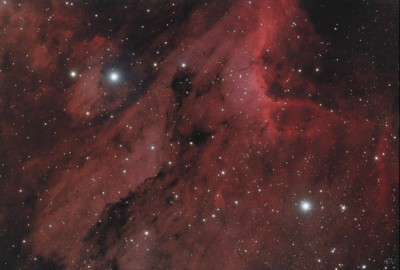| © Reinhard Wallner | IC5070 Pelikannebel_close up |
IC5070 |
|
The Pelican Nebula (also known as IC5070 and IC5067) is an H II region associated with the North America Nebula in the constellation Cygnus. The gaseous contortions of this emission nebula bear a resemblance to a pelican, giving rise to its name.The Pelican Nebula is located nearby first magnitude star Deneb, and is divided from its more prominent neighbour, the North America Nebula, by a molecular cloud filled with dark dust. The Pelican is much studied because it has a particularly active mix of star formation and evolving gas clouds. The light from young energetic stars is slowly transforming cold gas to hot and causing an ionization front gradually to advance outward. Particularly dense filaments of cold gas are seen to still remain, and among these are found two jets emitted from the Herbig–Haro object 555. Millions of years from now this nebula might no longer be known as the Pelican, as the balance and placement of stars and gas will leave something that appears completely different. Der Pelikan-Nebel IC5070 liegt in der Nähe des Nordamerikanebels (NGC 7000). Es handelt sich hierbei um einen diffusen Gasnebel im Sternbild Schwan. IC 5070 erhielt seinen Namen aufgrund seiner Form, welche an einen Pelikan erinnert. Der Gasnebel ist ca. 1.500 Lichtjahre entfernt und besteht überwiegend aus Wasserstoff, der teilweise in ionisierter Form (HII) auftritt und sichtbares Licht in Form von tiefroter Strahlung emittiert.
|
 |
für 100% Ansicht von IC5070 hier klicken
|
Montierung |
10 Micron 2000QCI | ||||
|
Equipment |
TEC 1120/160 | ||||
|
Guiding |
MGen TS 80/320 | ||||
|
Kameratyp |
ALCCD10c | ||||
|
Belichtung |
12x10Minuten Gain 10 Offset 127 | ||||
|
Brennweite |
1120 | ||||
|
Ort / Datum |
Biedermannsdorf 24.Juni 2012 | ||||
|
Entfernung |
1800LJ | ||||
|
Sternbild |
Schwan | ||||
|
|||||
|
Orientierung |
Norden ist oben | ||||
|
Bemerkungen |
EBV mit Theli und PS CS3 | ||||
| Zurück zu Nebel | |||||
| Zurück zu Astro Fotos | |||||